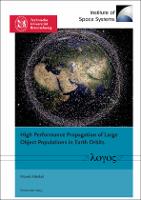High Performance Propagation of Large Object Populations in Earth Orbits
| dc.contributor.author | Möckel, Marek | |
| dc.date.accessioned | 2022-06-18T05:34:49Z | |
| dc.date.available | 2022-06-18T05:34:49Z | |
| dc.date.issued | 2015 | |
| dc.identifier | OCN: 1021809748 | |
| dc.identifier.uri | https://library.oapen.org/handle/20.500.12657/56757 | |
| dc.description.abstract | Orbital debris is becoming an increasing problem for space flight missions. New satellite launches, explosions, collisions and other events cause a steady rise in the number of objects orbiting the Earth. It is therefore important to determine the future development of the object population, as well as the effectiveness of debris mitigation measures, in long-term simulations. Orbital propagation, the calculation of an object's movement in its orbit, poses a challenge for this research due to the high computation times of the complex perturbation models involved. With populations consisting of hundreds of thousands of objects as well as simulation time frames of up to 200 years, these calculations can take up hours of computation time. To speed up this process, the analytical propagator Ikebana is introduced in this work of applied computer science in engineering. The program runs on graphics processing units, hardware designed for massively parallel execution of up to thousands of concurrent threads. This reduces the overall run time for large object populations from hours to minutes. Porting software from a conventional CPU is not a trivial task and involves a number of potential pitfalls and optimization opportunities which are detailed in this work. The propagator is integrated into other applications via a generic, multi-platform interface specifically designed for this task. It allows to develop the propagator separately and integrate it into other tools as a plugin at run time. The interface's architecture serves as a design template for analytical propagation software. | |
| dc.language | English | |
| dc.subject.other | Computers | |
| dc.subject.other | Computer Science | |
| dc.subject.other | Technology & Engineering | |
| dc.subject.other | Science | |
| dc.subject.other | Physics | |
| dc.title | High Performance Propagation of Large Object Populations in Earth Orbits | |
| dc.type | book | |
| oapen.identifier.doi | https://doi.org/10.30819/4165 | |
| oapen.relation.isPublishedBy | 1059eef5-b798-421c-b07f-c6a304d3aec8 | |
| oapen.relation.isFundedBy | b818ba9d-2dd9-4fd7-a364-7f305aef7ee9 | |
| oapen.relation.isbn | 9783832541651 | |
| oapen.collection | Knowledge Unlatched (KU) | |
| oapen.imprint | Logos Verlag Berlin | |
| oapen.identifier | https://openresearchlibrary.org/viewer/e42b09bb-96de-4cf1-a313-73c24846a03b | |
| oapen.identifier.isbn | 9783832541651 | |
| grantor.number | e42b09bb-96de-4cf1-a313-73c24846a03b |

